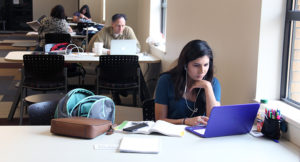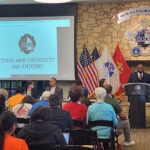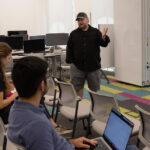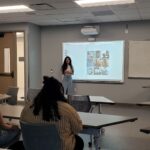By Norma Laura
University staff say they are responding to an influx of students and the need for additional computing resources. Staff are looking for the best solutions to accommodate students, especially since many do not own their own computers.
According to Jane Mims, director of institutional research, student enrollment will expand to 5,817 during Fall Term 2017. Texas A&M University-San Antonio’s Brooks City Base campus will close its doors this fall semester, permanently relocating students to Main Campus.
Meanwhile, faculty and staff recognize a call for action is needed to accommodate staff and students with the right tools to provide a suitable learning environment.
“We know that we need to increase the number of computers that we have available to students. There are already plans in place to expand the number of computers available in the library,” said Curtis Spears, assistant vice president for information technology services.
Spears said the goal is to avoid having insufficient computers in classrooms, prevent students from spending money on a personal laptop, and avoid waiting lines in the campus’ computer labs.
Computing Resources
Students currently have access to three open-access labs: two located on Main Campus and the third at the Brooks City-Base Campus.
- The library provides more than 50 Windows computers and is open 8 a.m. -9 p.m. Monday through Thursday; 8 a.m. – 6 p.m. Friday through Saturday; and 1p.m. – 9 p.m. Sundays.
- Patriots’ Casa computer lab located at Main Campus provides ten Windows computers. The lab operation hours run from 7:30 a.m. – 10 p.m. Monday through Thursday; 7:30 a.m. – 6 p.m. on Fridays; 8 a.m. – 5 p.m. on Saturdays; and 1p.m. – 5 p.m. on Sundays.
- Brooks City Base lab in Room 200 provides 32 Windows computers open 7:30 a.m. to 8 p.m. Monday through Thursday; 7:30 a.m. to 5 p.m. Fridays; 8 a.m. to 1 p.m. Saturdays; and 1p.m. to 5 p.m. Sundays.
- In addition, 96 Windows and 62 Macs are distributed in the standard computer classrooms at Main Campus. Plans are under way for a computer classroom in spring of 2017. Brooks City-Base Campus provides 24 Windows for the standard computer classrooms.
University might increase Laptop Carts
After Brooks Campus permanently closes, remaining computers will be placed at Main Campus.
Campus leadership approved a project to install at least 40 lab computers in the Central Academic Building and 12 computers to the library laboratory.
Spears said one of the reasons the computers have not been implemented sooner is because of the challenge to find the right space to install them. One solution, he offered, is “classrooms on wheels.” In this scenario, a portable laptop cart could be transferred to various classrooms upon request within the Central Academic Building.
“The classroom on wheels allows you to have the computers out when you want them and not out when they are not needed,” Spears said. “One of the problems with fixed computers is that if you are in a classroom that does not require computers the monitor can get in the way between the eye contact of the faculty and the student.”
Although placing a computer on a desktop with a monitor is the simplest and most economic way to go, the technology department wants to find the best method that ensures greater flexibility for staff and students. Depending on their needs and preferences, each student has the option to bring their own laptop or work on the computing resources offered on campus.
Students regularly use computer labs
Sociology junior Janice Castillo said she relies on campus resources to do her work for three semesters and never encountered problems accessing a computer. She said relying on campus computers was more convenient than going to a public library.

Castillo said she comes in two hours before her classes begin to complete her class assignments.
“Some of the hours are better here than at a public library because they close at 8 p.m., but you will have it longer here until 9 p.m. and at the military building it is open until 10 p.m,” Castillo said.
Some professors rely heavily on technology to teach their students.
“We are a program where we give students tasks and they have to create documents. They have to write, revise, edit, and design…not having computers inhibits the ability for us to have the kinds of exercises that would really be helpful for the students,” said Scott Gage, assistant professor of English.
Classes like the one Gage teaches provide a podium computer for the professor, but students have to bring their own devices. Problems arise because not every student owns their own computer.
“We have students in these classes who are working on smartphones and they are not able to have the same affordances. You see them holding their phone up to their face trying to read,” Gage said.
Library staff also notice an increase of students using the space available to complete work on computers.
Although the increased usage of computers is evident, Stefanie Wittenbach, university Librarian said students rarely have to wait for a computer to be available.
“That has not happened too often yet,” Wittenbach said. “It has happened a handful of times in the semester. We expect that will be more of an issue.”
The ITS department continues to work with library staff in developing a suitable plan to fulfill staff and students needs.
“They are aware of it and they are planning for it. At this stage we will just have to wait and see how it unfolds,” Spears said.






